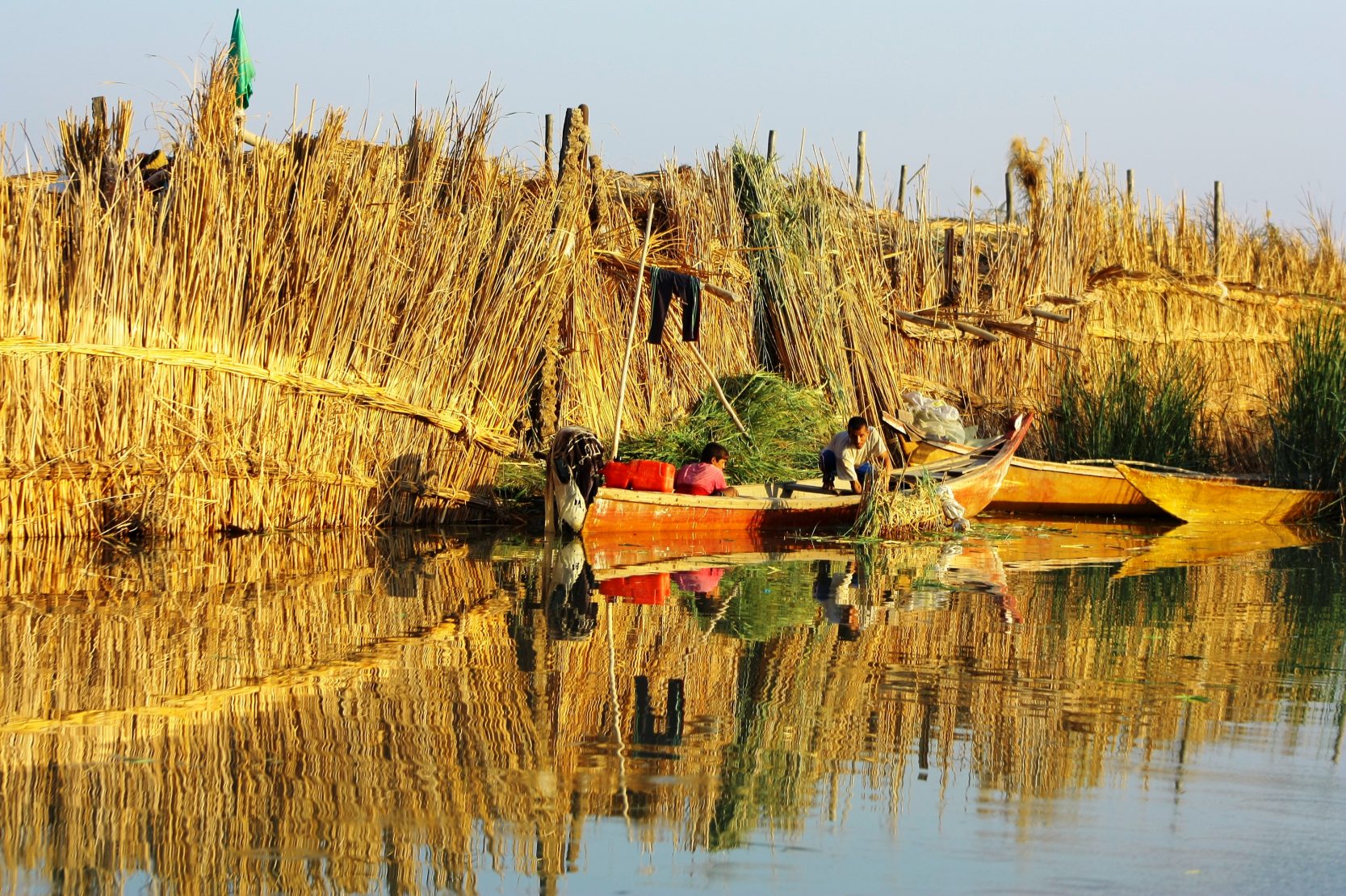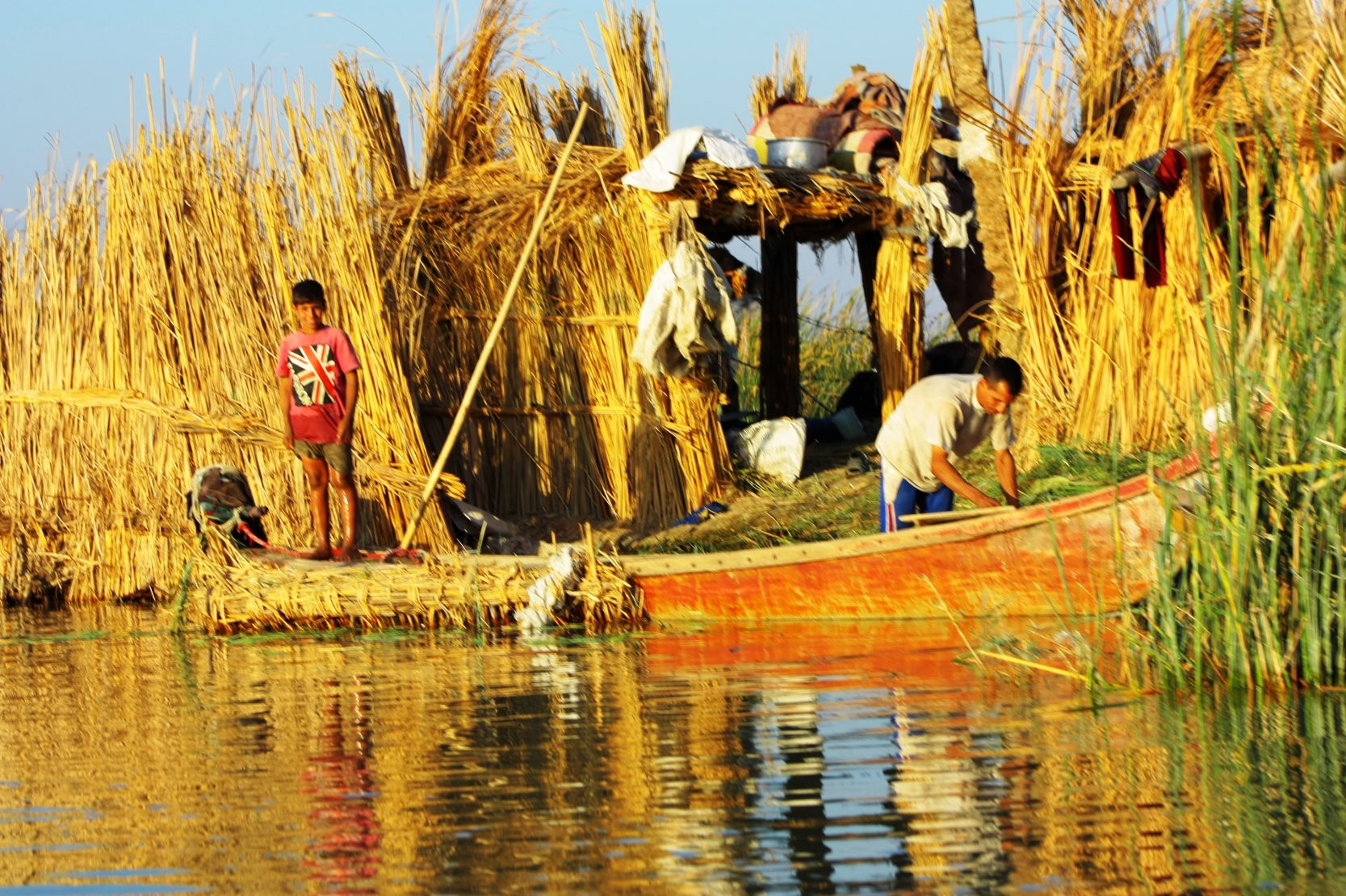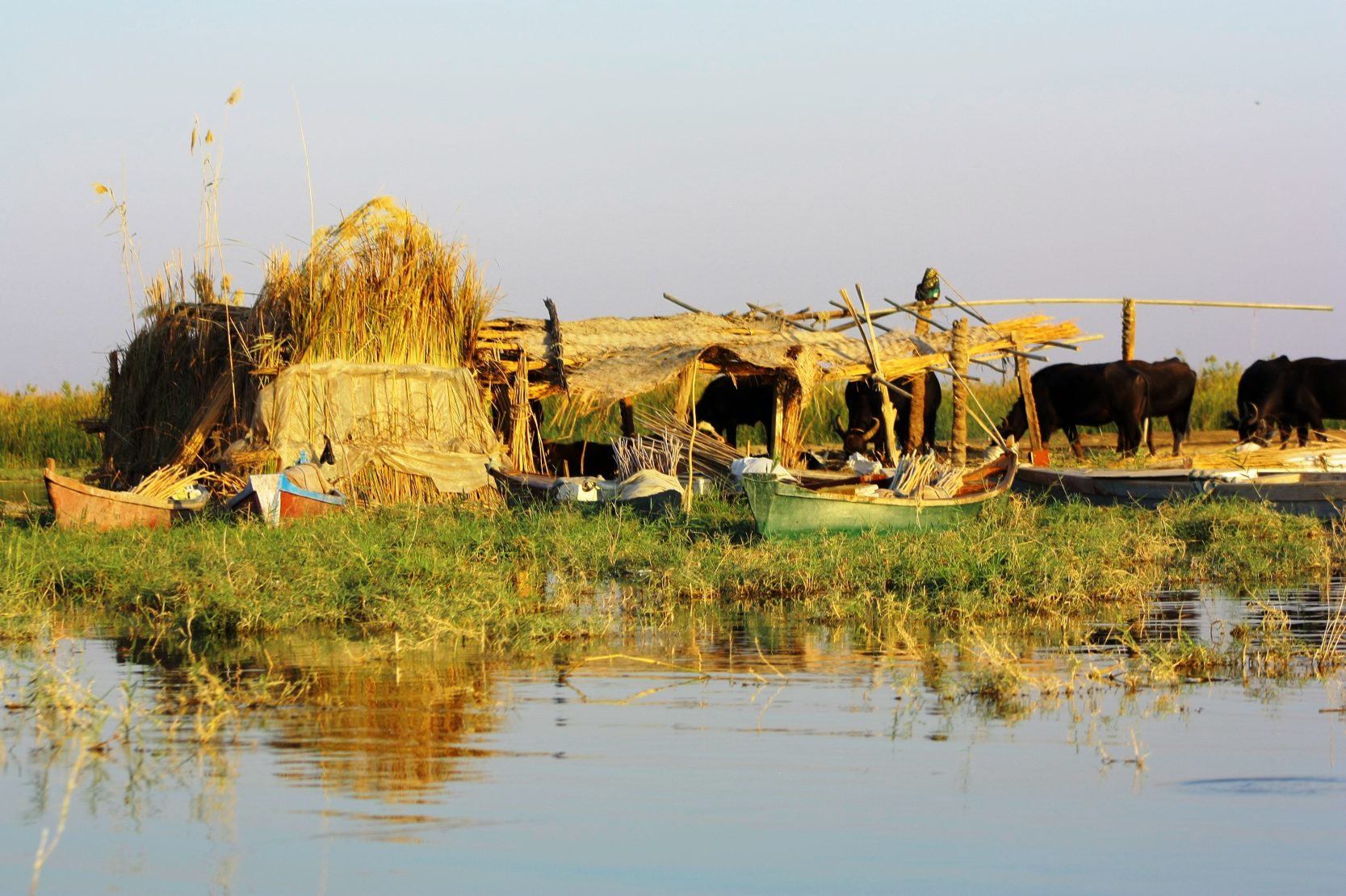
Early in the morning on a mid-September day, we head Southward to the Dilmij Marsh in the town of ‘Afak, located between al-Diwaniyah in the west and al-Kut in the east. Our friend and colleague, Tahseen al-Zarkani, recommends butter fava for breakfast, at a local restaurant in al-Diwaniyah. Butter fava is a rich Iraqi meal consisting of bread crumbs dipped in fava beans’ broth, and served with butter, a fried egg, and vegetables. Many, like us, stop for this popular dish before continuing on to their final destination. The Dilmij Marsh feeds at the confluence of the Tigris and Euphrates rivers. This artificial reservoir occupies a central place for south Iraq’s biodiversity. Migratory birds from Europe and Asia take a rest from the journey by the basin, which also hosts a large quantity of animals, from fish to foxes, buffaloes, and wild boars.
We reach al-Dilmij’s periphery a little after sunrise. Rising out of the teal-blue water, a welcome fresh breeze ruffles the reeds before it reaches us. Above us, flying birds bespeak a diversified life around the lake. Foxes whizzing in and out of the dense vegetation make us imagine the lake’s “inner life” if one could use such term. Only an hour into sunrise, a rising temperature sneaks upon us. Animals and birds suddenly dwindle. Fishermen carry their gear and return to their villages. We exchange only a few niceties; it is already too hot to have a long conversation. The further away we move from the oxygen-generating lake and the surrounding water bodies, the higher the temperature. By noon, it reaches 41°C (105.8 degrees Fahrenheit.) If the land is considered Iraq’s body, then lakes and reservoirs, along with their flora, are Iraq’s lungs.
These water bodies provide oxygen, appease the heat, and create a hospitable environment for a diverse fauna. However, these lungs’ upper part suffers from negligence, abandonment, and blatant human interference. For example, farmers from al-kut who have clout, are given license to drain the marshes to breed buffaloes.


Such transgressions are also committed against the Tigris and Euphrates, and their tributaries in the south. Activists in Basra and al-Diwaniyah told me the water is stolen, through pipes and artificial tributaries, to operate illegal fish farms, owned by politicians.
Filled with floodwater and drainage, al-Dilmij’s water quality is inferior to other Iraqi marshes’. However, reeds play a major role in reducing water pollutants, making it a habitat for birds and animals, in addition to enhancing its agricultural function.
By absorbing pollutants from water bodies, reeds can be said to be Iraq’s kidneys, as Dr. Haider Ibrahim puts it, a researcher at the Environment Directorate of Basra. His colleague Azhar Mekki, who holds a Masters degree in Cane Papyrus studies, points out that reed plants work by absorbing, not filtering, pollutants. She explains that a bacteria found in reeds is able to decompose water phosphates and nitrates. Reeds come in handy in an area where poor sanitation systems send wastewater into rivers and watersheds.
Before 2003, water precipitation was high and would have been enough to fill all the country’s marshes. But during the 1991 Gulf War, and in order to suppress his opponents in the south, Saddam Hussein erected dams on tributaries and lowlands’ water gateways, draining southern reservoirs, and forcing populations into displacement.


Jassim al-Asadi, a researcher and environmentalist at Nature Iraq Organization, recounts that, “After the regime fell in 2003, there was a concerted effort to bring the marshes back to life. Local people did not wait for the state to do the repair. They went and broke down the regime’s dams in Amarah, Nasiriyah and Basra, and thus revived their marshes, and went back home.
A few years later, in 2009, the country witnessed a “terrible” drought, as al-Asadi describes it. So terrible indeed that the water released from Turkey and Syria was not even sufficient for irrigation. Marshes at the confluence of the Tigris and Euphrates dried up, and villagers were forced to migrate to cities.
In an effort to avert further damages from the drought, a channel was dug between the drainage network and the northern Hammar Marshes in Nasiriyah & Basra, and a soil bund was built on the Euphrates river to help raise water levels in al-Chibayish lake, the primary water body that feeds Hammar and the central marshes.
The results were encouraging at first. In 2014, the marshes’ condition improved and there was water aplenty. But in 2016, the drought hit again and continued to reach its peak in 2018. Farmers had to be content with basin water to sustain an economy that is reliant on fishing and buffalo and cow breeding. There was a shortage of reed, too, which people use to build houses, as well as to make local dishes such as khorret (a popular dessert made with reed flour.)


“The southern marshes of Hawizeh completely dried out, driving away the entire population of the surrounding villages. Some headed to cities such as al-Najaf and al-Kut. Others settled around Lake Dilmij, or were scattered around al-Chibayish Marshes, with what little quantity of water was saved there,” al-Asadi said in a speech on the drought-induced migration.
In the winter of 2019, heavy rainfall filled the Iraqi reservoirs again. The southern Hawizeh Marshes were brought back to life for the first time since 2009, back when floodwater originating in neighboring Iran was so mismanaged by the authorities there that it left the marshes dry in the end.
Rainfall also increased water release from Turkey, further helped by the floods occurring inside the country.
With that, water flowed naturally again into the central marshes, swelling the Tigris River where water levels rose to an historic 160 m3, after having stagnated for decades at 2m3.
For the first time in years, green was back everywhere.
Al-Asadi believes that a protracted drought particularly endangers marshes: “It harms the architecture industry, heavily reliant on reeds, which grow only in a humid land. Reed guesthouses draw their architectural tradition from ancient Sumerians. In 2003, and after years of reed shortage during Saddam’s regime, guesthouses proliferated in cities like al-Chibayish.”
In the long run, al-Asadi says, “climate change threatens the very existence of marshes, especially climate events taking place at the headwaters of the Tigris and Euphrates rivers in Southeastern Anatolia and the Kurdistan Mountains where snow fall has been negligible in comparison with the past.”
Al-Asadi believes that climate change and the policies of countries that control the water sources go hand in hand. Turkey’s Ilısu Dam―on the Tigris along the Turkish borders―might reduce the flow of water by as much as 40%, leading to catastrophic effects on the Iraqi marshes, that would be hard to rectify.
Also, you have Iran’s water policies regarding the Karkheh and Karun Rivers and their 100 tributaries, which are by far the major source feeding the marshes along the Iraqi border: “The neighboring countries’ aggressive policies regarding water distribution and control make it impossible to imagine a good water governance in Iraq and hampers future water agreements between Iraq and the upstream states of Turkey, Syria and Iran.”
In addition to all of the above, other internal factors impede the fair management of water in Iraq, like rice growing in large quantities during the years of drought, knowing that rice crops in the Middle Euphrates region― Najaf, Diwaniyah and Samawah― waste vast amounts of freshwater, causing colossal damage to marshes that may lead down the line to their disappearance.
In the end, a possible loss of marshes in Iraq will trigger losses on so many other levels: domestic economies, biodiversity, and wetland areas.
And it will not be solely Iraq’s loss. The whole region will lose, too.
* Photos by Jassim al-Asadi






